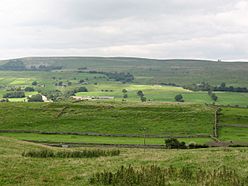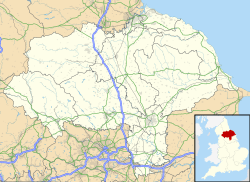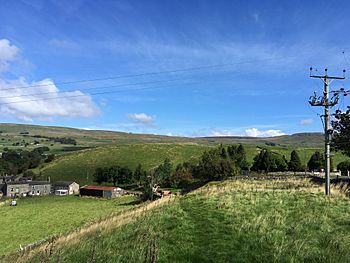Virosidum facts for kids
Quick facts for kids Virosidum |
|
|---|---|
 |
|
| Alternative name(s) | Virosidum |
| Known also as | Bainbridge Roman Fort |
| Founded | c. AD 90 |
| Place in the Roman world | |
| Province | Britannia |
| Stationed military units | |
| — Cohorts — | |
| Cohors VI Nerviorum | |
| Location | |
| Coordinates | 54°18′22″N 2°05′49″W / 54.306°N 2.097°W |
| Town | Bainbridge |
| County | North Yorkshire |
| Country | England |
| Reference | |
| UK-OSNG reference | SD93769015 |
| Site notes | |
| Condition | Ruined |
Virosidum was an ancient Roman fort and a small settlement that once stood near the modern village of Bainbridge, North Yorkshire, England. Today, it's a special protected site called a Scheduled monument, which means it's an important historical place.
Contents
Location of the Roman Fort
The fort was built in a very smart spot on top of Brough Hill. This location was perfect because it was between two rivers, the River Bain and the River Ure. From here, the Roman soldiers could see far across Wensleydale. They likely chose this spot to control an important mountain pass through the Pennines, a range of hills in northern England.
History of Virosidum Fort
The fort you can see today was mostly built between AD 90 and 105. It might have had an earlier version before that.
At first, the fort had walls made of earth and timber. These were later rebuilt with stronger materials around AD 190. The fort's defenses covered an area of about 1.16 hectares (2.8 acres).
The fort's platform still stands about 3.9 meters high. It was protected by one ditch on the north, east, and south sides. On the west side, there were five ditches for extra protection! There was also an extra area next to the fort, called an annexe, which measured 99 meters by 73 meters.
The Romans left the site for a while, between about AD 120 and 160. Later, in the early third century, a group of Roman soldiers called the Cohors VI Nerviorum rebuilt the inside of the fort. More rebuilding happened in the late fourth century. Pottery found there suggests the fort was used until quite late in the Roman period.
Discovering and Digging Up the Fort
People have known about this fort for a long time. In 1586, a writer named William Camden called it Bracchium in his book Britannia. This name even appeared on early maps.
The first official digs, or excavations, at the fort happened in 1925-26. These were led by John Kirk and R. G. Collingwood. More excavations took place in 1928-29 and 1931. Later, from 1950 to 1969, many more digs were done by archaeologists from Leeds University, including William V. Wade and Brian Hartley.
What Archaeologists Found
During these digs, archaeologists found five special stone carvings, called inscriptions. Three of these were put up by the Cohors VI Nerviorum, the Roman army unit stationed there. The other two were dedicated to different army groups. Many smaller items found during the 1956-1969 excavations are now kept at the Yorkshire Museum.
Bainbridge After the Romans
There isn't much proof that people continued to live at the fort right after the Romans left in the fifth century. However, something very interesting was found inside the fort's main building, called the principia.
Archaeologists discovered two burials there from a much later time. One was an adult, aged 36-45, and the other was a woman, aged 46 or older. Scientists used Radiocarbon dating to figure out that these people were buried in the ninth or tenth centuries AD.
They also used a method called Isotope analysis on the teeth of the skeletons. This showed that the woman probably grew up in the Yorkshire area. But the other person likely came from a western coastal part of Britain or even from mainland Europe! These burials, along with changes to the building, suggest that the principia might have been used as a church after the Romans left.
See also
 In Spanish: Virosidum para niños
In Spanish: Virosidum para niños




